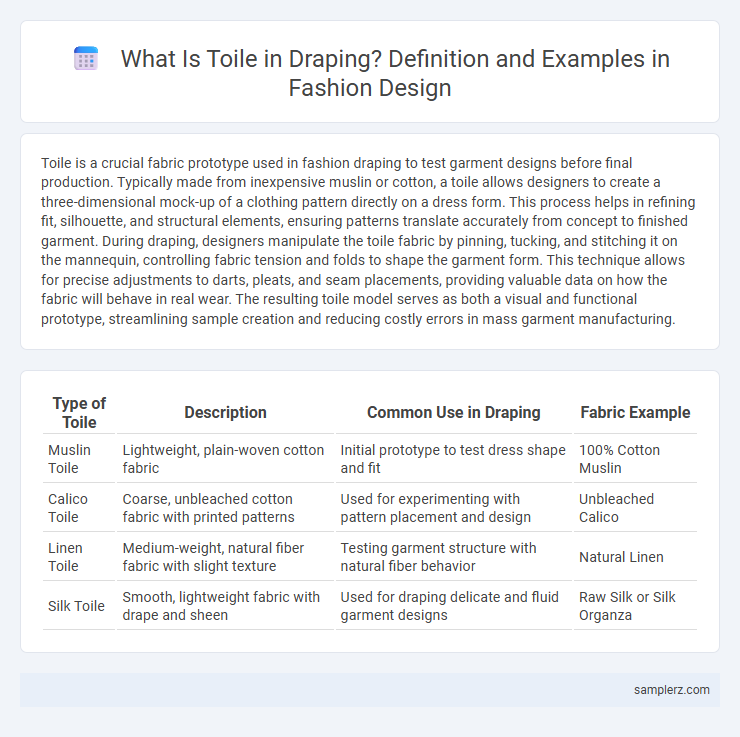Toile is a crucial fabric prototype used in fashion draping to test garment designs before final production. Typically made from inexpensive muslin or cotton, a toile allows designers to create a three-dimensional mock-up of a clothing pattern directly on a dress form. This process helps in refining fit, silhouette, and structural elements, ensuring patterns translate accurately from concept to finished garment. During draping, designers manipulate the toile fabric by pinning, tucking, and stitching it on the mannequin, controlling fabric tension and folds to shape the garment form. This technique allows for precise adjustments to darts, pleats, and seam placements, providing valuable data on how the fabric will behave in real wear. The resulting toile model serves as both a visual and functional prototype, streamlining sample creation and reducing costly errors in mass garment manufacturing.
Table of Comparison
| Type of Toile | Description | Common Use in Draping | Fabric Example |
|---|---|---|---|
| Muslin Toile | Lightweight, plain-woven cotton fabric | Initial prototype to test dress shape and fit | 100% Cotton Muslin |
| Calico Toile | Coarse, unbleached cotton fabric with printed patterns | Used for experimenting with pattern placement and design | Unbleached Calico |
| Linen Toile | Medium-weight, natural fiber fabric with slight texture | Testing garment structure with natural fiber behavior | Natural Linen |
| Silk Toile | Smooth, lightweight fabric with drape and sheen | Used for draping delicate and fluid garment designs | Raw Silk or Silk Organza |
Introduction to Toile in Draping
Toile in draping serves as a crucial prototype made from inexpensive fabric, allowing designers to experiment with garment shapes and fit before finalizing patterns. This preliminary garment helps identify structural adjustments and fabric behavior on the human form, ensuring precision in the final piece. Emphasizing tactile interaction and three-dimensional shaping, toile refines design concepts through hands-on manipulation on the dress form.
Historical Significance of Toile in Fashion Design
Toile, a prototype garment made from inexpensive fabric, played a crucial role in fashion design by allowing designers to perfect garment fit and structure before final production. Historically, toile has been used since the 18th century, particularly in haute couture houses, to experiment with silhouette and drape without wasting costly materials. This practice remains essential for maintaining precision in creating complex, tailored pieces that reflect period-specific styles and craftsmanship.
Purpose and Benefits of Creating a Toile
Creating a toile in draping serves as a critical step for designers to visualize garment structure and fit before cutting into expensive fabric, allowing precise adjustments without risk. This process ensures optimal pattern accuracy, reduces material waste, and enhances overall garment quality by addressing fit and proportion issues early. Utilizing a toile streamlines production by identifying potential design flaws, ultimately saving time and cost in fashion design and tailoring.
Key Materials Used for Toiles
Toiles in fashion draping primarily use inexpensive, plain-woven cotton muslin due to its affordability and ease of manipulation. Lightweight linen and calico fabrics are also common choices because they hold shape well and provide a clear canvas for adjustments. These materials allow designers to experiment with silhouettes and fit before cutting into costly fashion fabrics.
Step-by-Step Process of Toile Construction
Creating a toile in draping begins with selecting a plain cotton or muslin fabric to draft the initial garment shape directly on a dress form. The fabric is pinned and manipulated to achieve desired contours, with seams and darts marked for accuracy before the material is carefully removed from the form. This step-by-step toile construction allows designers to perfect fit and proportion before cutting final fashion fabrics, reducing waste and ensuring precision in garment production.
Toile vs. Final Garment: Understanding the Differences
Toile refers to a prototype garment constructed from inexpensive fabric used in draping to test fit, shape, and design before final production. Unlike the final garment, which is crafted from high-quality materials and finished with refined details, the toile serves as a functional mock-up for adjustments and evaluation. Understanding the differences between toile and final garment is essential for designers to perfect the silhouette and structure without the cost of wasted premium fabric.
Common Mistakes in Toile Draping and How to Avoid Them
Common mistakes in toile draping include improper fabric choice, incorrect seam alignment, and inadequate pinning, which can distort the garment's shape and fit. Using lightweight, non-stretch fabrics like muslin provides a better representation of the final design and prevents fabric distortion during the draping process. Ensuring precise seam placement and secure pinning helps maintain pattern accuracy and facilitates smoother adjustments before cutting the final fabric.
Real-World Examples of Toiles in Couture Houses
Toiles play a crucial role in couture houses like Chanel and Dior, where artisans create detailed fabric prototypes to perfect fit and design before final garments are crafted. These full-scale muslin models allow designers to refine silhouettes, ensuring precision and elegance in haute couture collections. By using toiles, ateliers achieve impeccable tailoring that defines luxury fashion standards worldwide.
Toile Fitting Adjustments: Techniques for Precision
Toile fitting adjustments in fashion draping involve precise techniques such as pinning, marking, and fabric manipulation to perfect garment structure before final tailoring. Mastering contouring methods on a muslin prototype allows designers to identify fit issues like excess ease or tension, ensuring an accurate silhouette. These adjustments optimize pattern accuracy, enhance fabric behavior understanding, and streamline the transition from toile to finished garment.
Toile as a Creative Tool in Experimental Fashion
Toile serves as an essential creative tool in experimental fashion by allowing designers to explore innovative silhouettes and fabric manipulations before final production. This preliminary garment, typically made from inexpensive muslin fabric, provides a three-dimensional canvas to test unconventional draping techniques and architectural shapes. Using toile enables iterative adjustments that push the boundaries of traditional garment construction while minimizing material waste and cost.

example of toile in draping Infographic
 samplerz.com
samplerz.com